You can listen to Hoosier History Live! live on the air each Saturday, or listen online at the WICR website during the broadcast on any computer with speakers, anywhere, or on a smartphone. We invite you to visit our website!
Dec. 17 show
Inter-church history in Indy
 Nearly 100 years ago, about 40 congregations gathered in downtown Indianapolis. Worried about gambling, alcohol trafficking and prostitution in 1912, the congregations formed one of the country's first church federations.
Nearly 100 years ago, about 40 congregations gathered in downtown Indianapolis. Worried about gambling, alcohol trafficking and prostitution in 1912, the congregations formed one of the country's first church federations.
In the beginning, black churches could not join the Church Federation of Greater Indianapolis. As the organization prepares to celebrate its centennial in 2012, its executive director is Rev. Angelique Walker-Smith, the first African-American and the first woman to serve in the top post.
To share insights about the history of the church federation - which has evolved from being an exclusively white and Protestant organization to one that includes Catholics, blacks and an array of other ethnic groups - Angelique will join Nelson in studio.
So will Marion County historian David Vanderstel. He's helping put together a history of the church federation, which rather quickly became an advocate for civil rights. During the 1920s, the federation opposed the Ku Klux Klan and its sway over city and state officials. 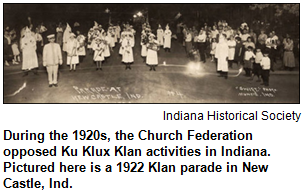 The federation also inspired other church councils across the nation and helped fund the launch of Gleaners Food Bank of Indiana.
The federation also inspired other church councils across the nation and helped fund the launch of Gleaners Food Bank of Indiana.
Among several events and projects marking its centennial in 2012, the church federation will partner with Habit for Humanity to build 10 homes in Indy. Other partners for the Habit for Humanity homes include Martindale-Brightwood Community Development.
The first home will be unveiled in June, which will be 100 years from the month when the 40 churches gathered in 1912. Back then, the congregations were alarmed at a decline in public morality that included "automobiles speed contests." A morals committee investigated the one-year-old Indianapolis 500, which just finished celebrating its own centennial era.
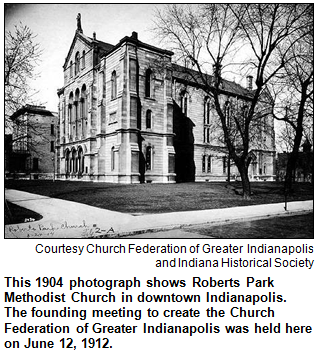 According to the Encyclopedia of Indianapolis, the new inter-church organization was one of only about six church federations in the nation in 1912, so it served as a model for others across the country. Among the local congregations, early concerns focused on crime and the prevalence of saloons.
According to the Encyclopedia of Indianapolis, the new inter-church organization was one of only about six church federations in the nation in 1912, so it served as a model for others across the country. Among the local congregations, early concerns focused on crime and the prevalence of saloons.
By the 1920s, though, the church federation was a vocal opponent of the KKK, which was peaking in power across the state. The federation objected to plans by Indianapolis city officials, including the mayor, to accept only applicants endorsed by the KKK for jobs in the department of public works. Also during the 1920s, white and black preachers had a pulpit exchange program.
During the 1940s, the Indy church federation fought racial discrimination at the U.S. Defense Department. Although generally advocating "peace and goodwill," the federation helped support chaplains for the military during World War II.
Over several decades, the federation also established chaplains at jails and hospitals in Indy. In addition, the organization helped recruit and supervise chaplains for what's now the Indianapolis Metropolitan Police Department, as well as chaplains at Indianapolis International Airport.
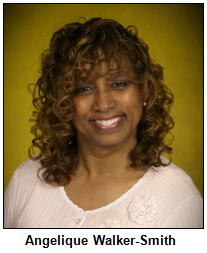 Eventually, Catholic parishes began joining the federation. So did Eastern Orthodox, Pentecostal and independent congregations.
Eventually, Catholic parishes began joining the federation. So did Eastern Orthodox, Pentecostal and independent congregations.
The diversity will be reflected in several events marking the centennial during 2012. They will include a "Week of Prayer for Christian Unity" series Jan. 16-21. Speakers will include Rev. Boniface Hardin (who will share insights about the life of the late Cardinal Joseph E. Ritter) and former Mayor William Hudnut, who was a Presbyterian minister before entering political life.
 Angelique Walker-Smith has been the church federation's executive director since 1995, the same year she became a volunteer chaplain at the Indiana Women's Prison. She is a graduate of Yale Divinity School and has lived in three African countries.
Angelique Walker-Smith has been the church federation's executive director since 1995, the same year she became a volunteer chaplain at the Indiana Women's Prison. She is a graduate of Yale Divinity School and has lived in three African countries.
Since assuming the top post at the church federation, Angelique has initiated a prayer vigil ministry that has been nationally recognized. Clergy of many faiths join civic leaders in prayer at the sites of violent crimes in Indianapolis and at the homes of victims and their families.
David Vanderstel, our other guest, has several affiliations in addition to being Marion County's official historian. He also is the executive director of advancement at Martin University. And David was our studio guest on Hoosier History Live! in March for a show about the Irish in Indiana.
 Other facts:
Other facts:
- Baby boomers and Gen Xers may recall Time for Timothy, a children's program produced by the church federation beginning in 1957. The series, which was broadcast on Channel 13, focused on a church mouse and often featured puppets interacting with live adults and children. Time for Timothy, which usually focused on Bible stories, stopped production in the early 1990s, although reruns continued several more years.
- During school desegregation in Indianapolis in the 1970s and '80s, the church federation trained chaplains to help ease tensions. The federation supported busing to achieve integration.
- Although the first of the 10 Habitat for Humanity houses will be unveiled in June, construction of the others will continue through next October. The 10 "centennial" houses will represent one for each decade of the church federation's history.
Roadtrip: Vintage film showing at Garfield Park
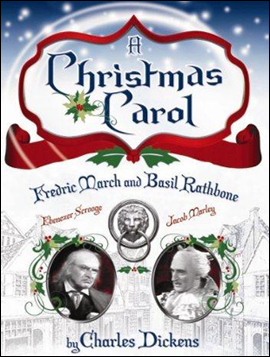 It doesn't get much better than Fredric March as Ebenezer Scrooge and Basil Rathbone as Jacob Marley. Our Roadtripper, Chris Gahl of the ICVA, tells us that the best heritage Roadtrip this week is the Vintage Film Night Series at Garfield Park Arts Center on the south side of Indianapolis.
It doesn't get much better than Fredric March as Ebenezer Scrooge and Basil Rathbone as Jacob Marley. Our Roadtripper, Chris Gahl of the ICVA, tells us that the best heritage Roadtrip this week is the Vintage Film Night Series at Garfield Park Arts Center on the south side of Indianapolis.
If you're missing that "whirr" of the film projector (or even that "snap" of the film breaking!), head to Garfield Park this Saturday, Dec. 17, at 7 p.m. The series will present a rare 1954 television version of A Christmas Carol. Yes, it's a 1950s version of the classic play by Charles Dickens, complete with music by Alfred Hitchcock!
Additionally, expect some lively vintage holiday shorts to be presented that evening by your host, film historian Eric Grayson, and his trusty elf assistant, public historian Glory-June Greiff.
Tickets are only $3, and popcorn and other concessions are available. The Garfield Park Arts Center has plenty of free parking and is located at 2432 Conservatory Drive in Garfield Park. Yes, here's an opportunity to lose that "Bah humbug!" feeling, should you happen to be afflicted with it.
History Mystery
Along with several cities across the country, Indianapolis sometimes has been called "the City of Churches."  But another city in Indiana, one of the largest in the state, is associated even more frequently with that nickname.
But another city in Indiana, one of the largest in the state, is associated even more frequently with that nickname.
For many generations, this city has been a regional hub for Lutherans, Catholics and Episcopalians. It also has a cluster of historic churches with tall steeples in its downtown. The city was the site of early organizational meetings for what became the Missouri Synod of the Lutheran Church.
Question: What is the Indiana city?
To win the prize, you must call in with the correct answer during the live show. Please do not call if you have won a prize from any WICR show during the last two months. The call-in number is (317) 788-3314, and please do not call until you hear Nelson pose the question on the air.
The prize is an overnight stay at the Renaissance Indianapolis North Hotel in Carmel, courtesy of the ICVA.
Your Hoosier History Live! team,
Nelson Price, host and creative director
Molly Head, producer, (317) 927-9101
Chris Gahl, Roadtripper
Richard Sullivan, webmaster and tech director
Pam Fraizer, graphic designer
Garry Chilluffo, creative consultant
Michele Goodrich, Jed Duvall, grant consultants
www.hoosierhistorylive.org
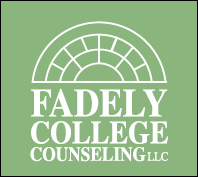

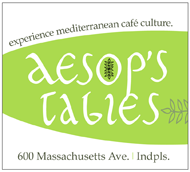


Please tell our sponsors that you appreciate their support: Aesop's Tables, Fadely College Counseling, Indiana Historical Society, Lucas Oil and Story Inn.
 Acknowledgments to Print Resources, Indianapolis Marion County Public Library, Monomedia, Indiana Humanities, Indianapolis Convention & Visitors Association, WICR-FM, Fraizer Designs, Heritage Photo and Research Services, Derrick Lowhorn, Samantha Stratton and many other individuals and organizations. We are an independently produced program and are self-supporting through organizational sponsorships, grants and through individual tax-deductible contributions through the Indiana Humanities Council. Visit our website to learn how you can support us financially.
Acknowledgments to Print Resources, Indianapolis Marion County Public Library, Monomedia, Indiana Humanities, Indianapolis Convention & Visitors Association, WICR-FM, Fraizer Designs, Heritage Photo and Research Services, Derrick Lowhorn, Samantha Stratton and many other individuals and organizations. We are an independently produced program and are self-supporting through organizational sponsorships, grants and through individual tax-deductible contributions through the Indiana Humanities Council. Visit our website to learn how you can support us financially.
Year-end support!
Keep Nelson talking in 2012 and beyond
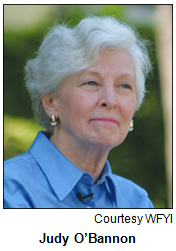 "What a fun and interesting way to learn about the heart and soul of our state. No boring class or books at Hoosier History Live!"
"What a fun and interesting way to learn about the heart and soul of our state. No boring class or books at Hoosier History Live!"
-
Judy O'Bannon, Indianapolis, former Indiana First Lady and producer of public television's Judy O’Bannon's Foreign Exchange
"As historical writers, we try to overcome the public's indifference to history, and to bring alive the important lessons of the past. Hoosier History Live! does this so well that we hope to see it broadcast far and wide over this historically significant state of Indiana."
- James Alexander Thom and Dark Rain Thom, Bloomington, Indiana, authors
If you would like to make an individual tax deductible donation by the end of 2011, write out a check to "Indiana Humanities" and mention "to benefit Hoosier History Live!" in the memo line of the check.
The check may be mailed to:
Indiana Humanities
Attn: Nancy Conner
1500 N. Delaware St.
Indianapolis, IN 46202
Be sure to include your name and return address so that you can receive a tax donation receipt from Indiana Humanities. Remember that you also can memorialize a loved one with your donation.
Coming up
Returning on Dec. 31
On Christmas Eve, Hoosier History Live! will be pre-empted by special holiday programming on WICR-FM. Please join us Dec. 31 at 11:30 a.m., when our show will return.
Hoosier History Live! events
Our fourth anniversary!
Mark your calendar for the Hoosier History Live! 4th anniversary party on Thursday, Feb. 16 from 5 to 8 p.m. at Morris-Butler House. Again, courtesy of Indiana Landmarks.
Also ... the Irvington Library Hoosier History Live! Radio Club continues to be "a weekly thing." The listening group meets weekly in the Story Theater of the Irvington Library, 5625 E. Washington St., at 11:30 a.m. on Saturdays.
And remember: You can "like" the Hoosier History Live! Facebook page and make comments about topics and shows, as well, on the page.
© 2011 Hoosier History Live! All rights reserved.